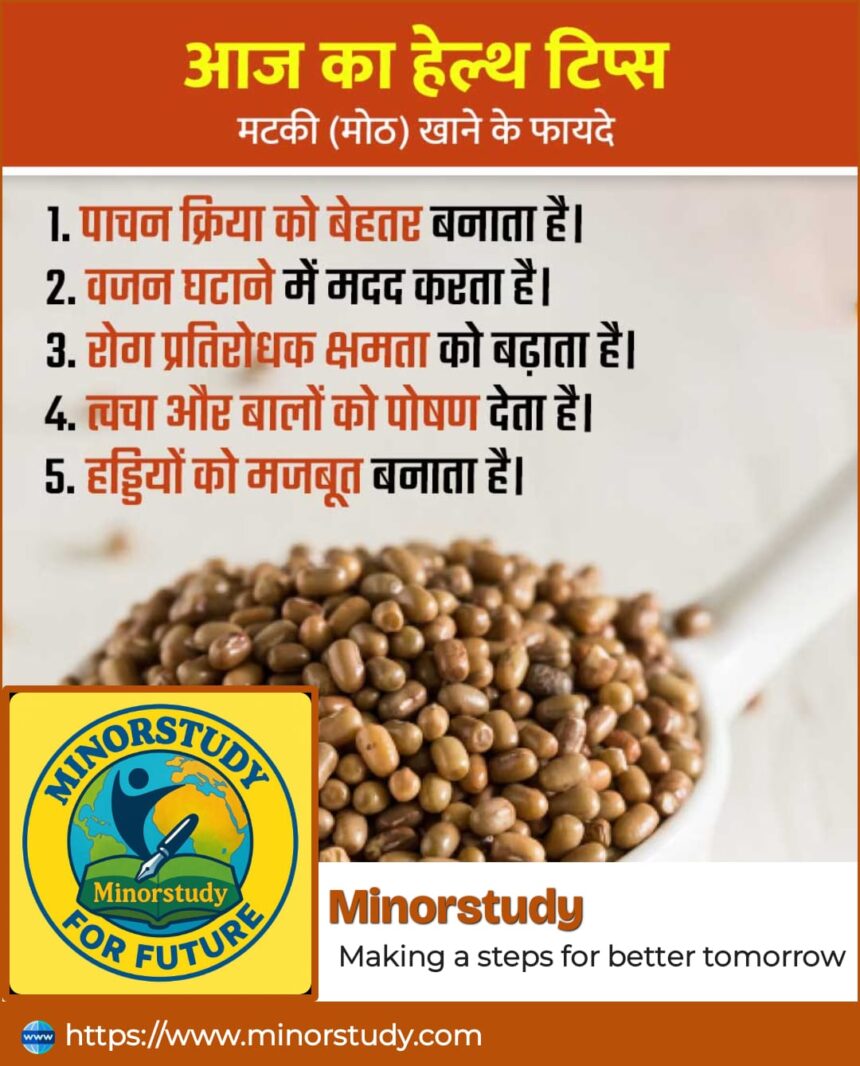5 Powerful Reasons Why Eating Matki (Moth) Daily Is a Game-Changer for Your Health
In the heart of traditional Indian kitchens lies an underestimated superfood — Matki, also known as Moth Bean. While often overshadowed by rajma, chana, or masoor dal, matki is a nutritional powerhouse and an essential part of holistic diets in India, especially in Maharashtra, Gujarat, and Rajasthan.
- 🌿 What is Matki (Moth Bean)?
- 🕰️ Historical Background of Matki
- 🌟 Top 5 Health Benefits of Eating Matki
- 1. ✅ Improves Digestion
- 2. ✅ Helps in Weight Loss
- 3. ✅ Boosts Immunity
- 4. ✅ Nourishes Skin and Hair
- 5. ✅ Strengthens Bones
- 🧾 Lesser-Known Facts About Matki
- 🙏 Cultural & Religious Significance
- ❓ FAQs About Matki (Moth Bean)
- Q1. Is matki suitable for daily consumption?
- Q2. Can diabetics eat matki?
- Q3. How to sprout matki at home?
- Q4. What’s the best way to cook matki?
- Q5. Is it safe for kids and pregnant women?
- 🧘♀️ Importance in Daily Life
- 🪔 Observance and Celebratory Use
- ✨ Wishing: Share the Matki Magic!
- 📌 Important Points Recap
- 🧭 Conclusion: Daily Life Impact & Reflection
From boosting digestion to strengthening bones, this tiny legume holds mighty benefits. Let’s dive deep into the history, health benefits, cultural significance, facts, and societal impact of Matki in a human-friendly and deeply researched format.
🌿 What is Matki (Moth Bean)?
Matki (Botanical name: Vigna aconitifolia) is a short-duration legume that grows in hot and dry regions, primarily in India. Its small, brownish seeds and strong drought resistance make it perfect for Indian climates.
It’s rich in:
Protein
Fiber
Calcium
Potassium
Iron
Vitamin B-complex
Whether sprouted, cooked, or mixed into sabzis, Matki is one of the healthiest, affordable, and versatile pulses in Indian cuisine.
🕰️ Historical Background of Matki
Matki’s cultivation goes back to ancient India, where it was a vital food source in arid regions. Historical texts and Ayurvedic scriptures mention its digestive and detoxifying properties.
📌 Timeline Highlights:
| Year/Period | Event Description |
|---|---|
| 2000 BCE – 1000 BCE | Earliest domestication in India’s semi-arid regions. |
| 700 CE | Mentioned in ancient Ayurvedic dietary treatises. |
| 1600s | Cultivated widely across western India due to drought tolerance. |
| Present Day | Rediscovered as a superfood in health-conscious diets globally. |
🌟 Top 5 Health Benefits of Eating Matki
1. ✅ Improves Digestion
Matki is rich in dietary fiber which:
Supports gut health
Promotes regular bowel movements
Prevents bloating and constipation
In Ayurveda, matki is used to balance vata and kapha, improving agni (digestive fire).
2. ✅ Helps in Weight Loss
Matki is low in calories, high in protein, and fills you up faster. Perfect for:
Reducing hunger pangs
Balancing blood sugar
Supporting fat loss
Sprouted matki is often included in weight loss diets and is a staple in Maharashtrian “Usal” dishes.
3. ✅ Boosts Immunity
Matki contains essential minerals like iron, zinc, and magnesium, which strengthen the immune system. These nutrients help:
Fight infections
Promote energy levels
Support metabolic functions
4. ✅ Nourishes Skin and Hair
Matki is rich in antioxidants and vitamin B-complex, which:
Delay skin aging
Improve complexion
Strengthen hair follicles
Prevent dryness
Its detoxifying nature purifies blood, improving overall skin health.
5. ✅ Strengthens Bones
Matki provides calcium, phosphorus, and magnesium, which help:
Improve bone density
Prevent osteoporosis
Strengthen teeth and joints
Perfect for growing children, menstruating women, and elderly individuals.
🧾 Lesser-Known Facts About Matki
🌱 Can Grow in Droughts: Requires very little water to grow.
🧪 Low Glycemic Index: Safe for diabetics when cooked properly.
🥗 Used in Sprouted Form: Popular in Indian and vegan diets.
🏋️ Excellent Post-Workout Food: High in protein for muscle recovery.
🍛 Staple of the Poor: Affordable and accessible, making it vital for food security.
🙏 Cultural & Religious Significance
Maharashtra: Matki Usal is a common offering during Gudi Padwa and festive fasting dishes.
Gujarat: Often used in khichdi and bhel, especially during Navratri.
Rajasthan: A survival food during droughts and desert conditions.
Ayurveda: Classified as laghu (light), good for detox diets and seasonal transitions.
❓ FAQs About Matki (Moth Bean)
Q1. Is matki suitable for daily consumption?
Yes, matki can be consumed daily in sprouted or cooked form, especially as part of a balanced diet.
Q2. Can diabetics eat matki?
Yes. It has a low glycemic index and helps stabilize blood sugar levels.
Q3. How to sprout matki at home?
Soak matki overnight
Drain and tie in a cloth
Keep in a warm place for 24-48 hours
Q4. What’s the best way to cook matki?
Sprouted: As a salad or chaat
Cooked: In curries, usal, khichdi, or dry sabzis
Q5. Is it safe for kids and pregnant women?
Yes, due to its high calcium, iron, and protein content, matki is safe and beneficial.
🧘♀️ Importance in Daily Life
Matki is not just food—it’s a functional medicine in many Indian households.
In Your Kitchen:
Easy to cook
Stores well for months
Versatile (can be used in salads, curries, sprouts, khichdi)
In Your Health:
Prevents deficiency diseases
Promotes natural healing
Boosts stamina and strength
In Rural India:
A lifeline in dry regions
Supports food security for farmers and low-income families
🪔 Observance and Celebratory Use
Matki is used:
During fasts and vrat days in sprouted form
In rituals for health and vitality in rural traditions
As part of Navratri thalis, nourishing and sattvic
✨ Wishing: Share the Matki Magic!
“🌱 Wishing you strength, vitality, and health with every spoon of Matki. Eat local, eat wise! 💪”
Encourage your friends and family to:
Switch to sprouted matki breakfasts
Include it in kids’ lunchboxes
Replace unhealthy snacks with matki chaat
📌 Important Points Recap
Matki (Moth) is a high-protein legume native to India.
Boosts digestion, weight loss, immunity, and bone strength.
Affordable, easy to cook, and culturally significant.
Great for all age groups and all diets, especially vegetarian or diabetic-friendly diets.
A complete superfood hiding in plain sight!
🧭 Conclusion: Daily Life Impact & Reflection
In today’s fast-paced world filled with artificial supplements and processed food, Matki offers a return to roots — a path toward natural health, sustainable nutrition, and affordable wellness.
Incorporating matki into your routine is more than a diet change — it’s a lifestyle choice that supports:
Your health
Your family
Your environment
Your culture
“Sometimes the simplest foods, like Matki, carry the most profound healing powers. Let’s honor what our ancestors knew all along — health begins in our humble kitchen bowls.”








